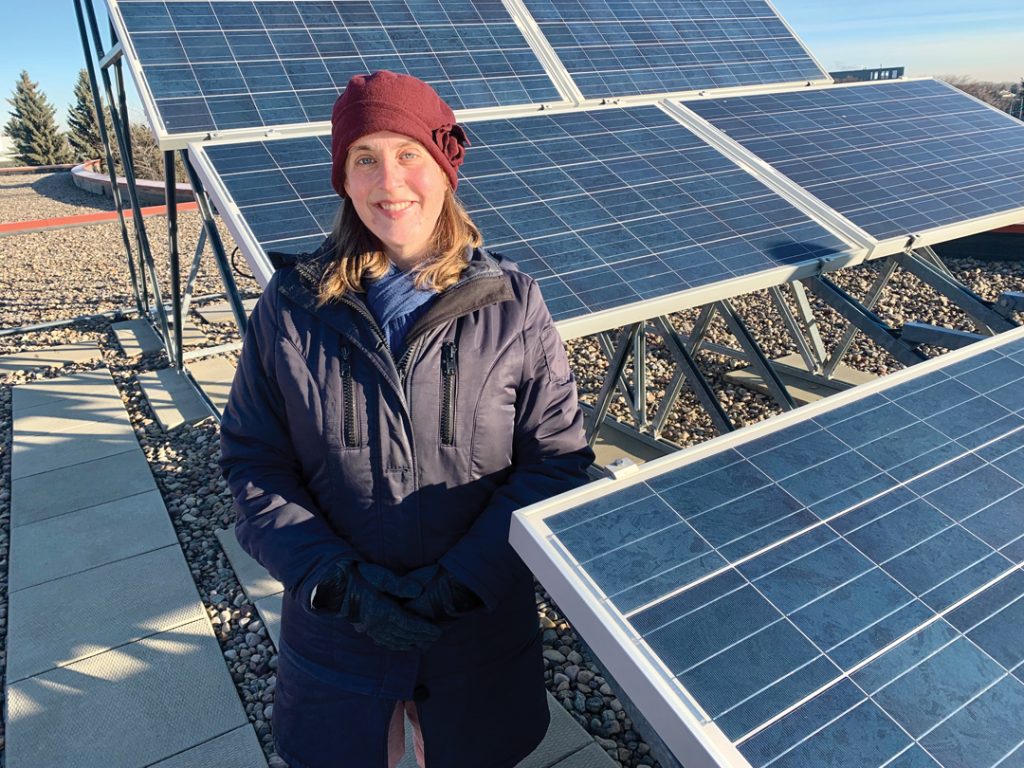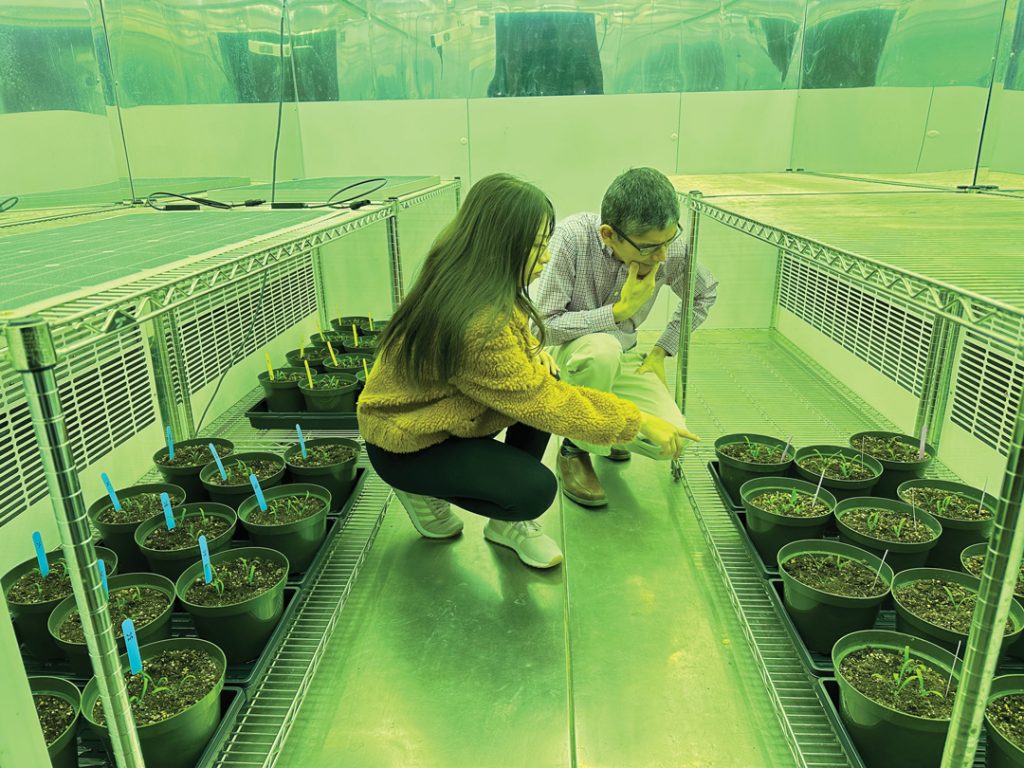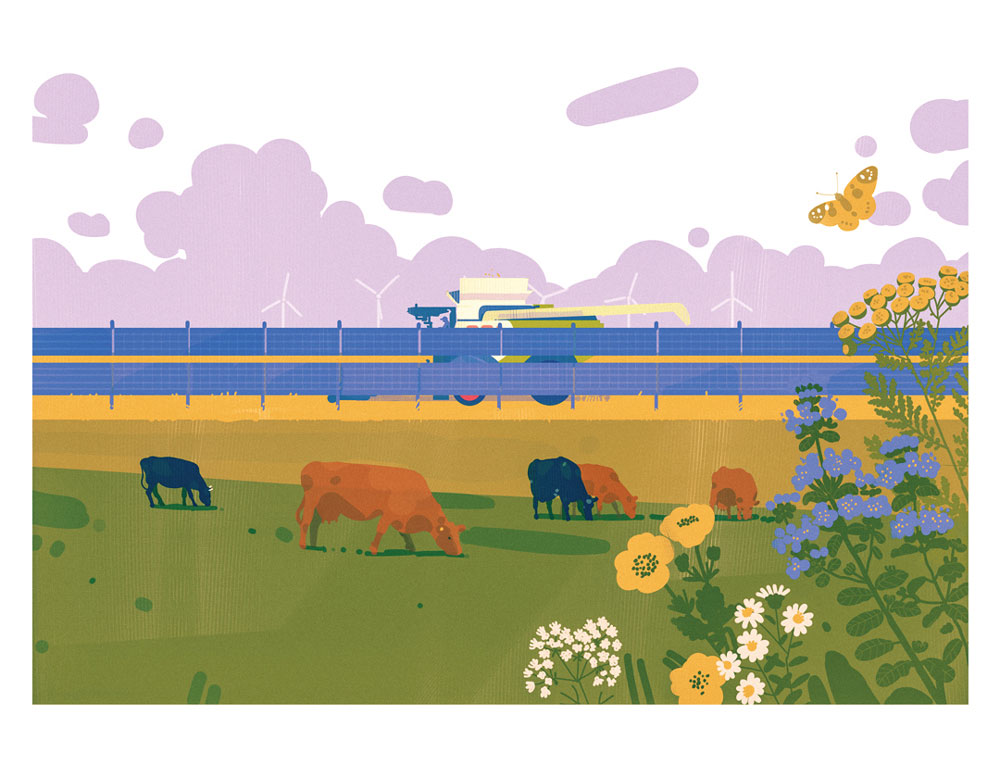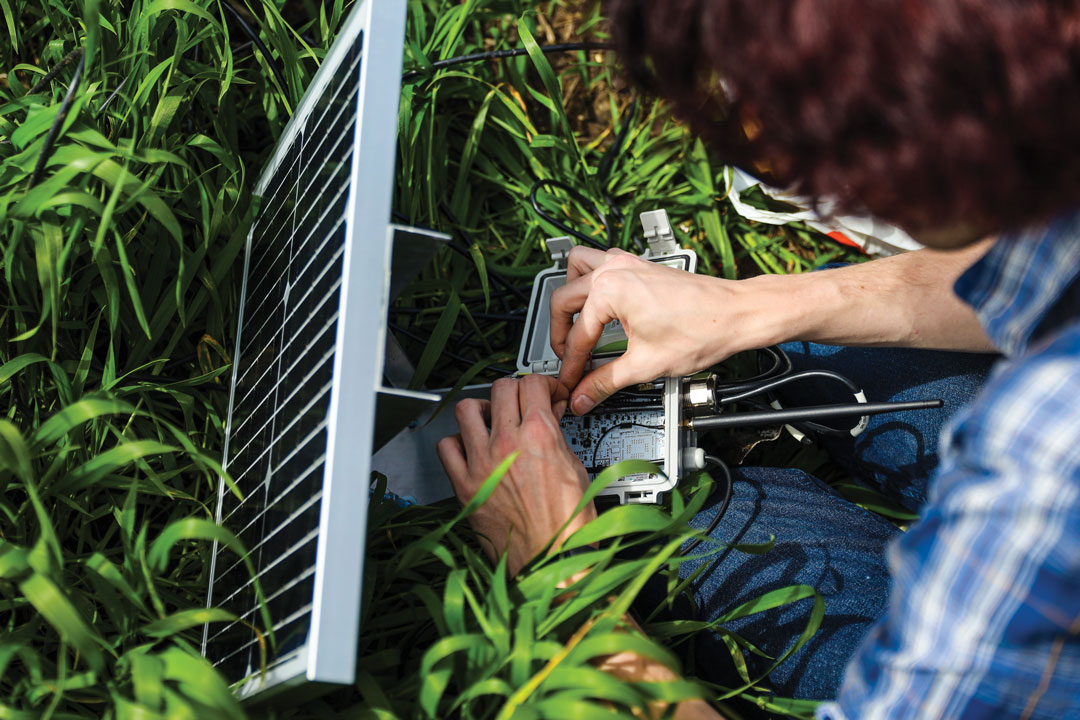SHARED ACCOMMODATION
BY TREVOR BACQUE • ILLUSTRATION BY DARYA SHNYKINA
Alberta is an energy producer, and this will not soon change. However, the way in which energy is generated has evolved. Oil and gas production remains the province’s golden ticket, but with a sustained push, renewables continue to fight for market share. So many projects have gone into development or are at the assessment stage, it’s been hard to keep up. One of the newest types of builds is agrivoltaics, which has attracted big interest from farmers and corporate investors alike.
The term agrivoltaics refers to the placement of agricultural production and solar panels on the same block of land. The fact solar arrays effectively take farmland out of production has been very controversial in rural Alberta. Where typical, angled solar panel projects render a field unusable for agriculture, apart from weed-chomping sheep and goat herds, agrivoltaics projects are configured to co-exist with farming. Solar panels are primarily installed upright, which produces minimal shadow. Panel rows are also spaced adequately to allow cattle to graze and farm machinery to operate between them. Renewable energy proponents frame agrivoltaics as a positive economic solution that allows farming and ranching to live in harmony with energy production.
In Alberta, to offset all carbon emissions produced in the province with agrivoltaics would require 1.4 per cent of the province’s agricultural land. In most other provinces the number is less than one per cent. Countrywide, it’s estimated between one quarter to more than one third of Canada’s electrical energy could be generated on just one per cent of farmland through agrivoltaics. There’s so much interest in this tech, farmers and solar companies have recently formed Agrivoltaics Canada, an industry association.
Solar panels, and renewable energy projects in general, were thrust into the limelight recently when the UCP government announced a pause on their development in August 2023. The moratorium was lifted Feb. 29, and new provisions and rules put in place to ensure farm production takes priority on arable land. One of the biggest changes is renewables are banned on class 1 and 2 lands unless the applicant can demonstrate that crops, livestock, or both, can co-exist alongside a renewable generation project. This is no problem according to renewable energy proponents. With the use of agrivoltaics, they say, everyone can have their cake and eat it, too.

“I like how agrivoltaics takes us away from this ‘either-or’ conversation and allows us to work together.” —Heather MacKenzie
At the office of Solar Alberta, a nonprofit group that serves community and industry, executive director Heather MacKenzie receives phone calls every day from farmers and investors who want to light up solar projects. Some request information to construct a basic system that will offset rising utility costs, while others want to connect with ambitious investors hungry for farmland to construct new projects.
“Over time, we’ll probably see solar playing a larger and larger role just because of the cost being so low,” she said. “It is cheaper to develop a solar or wind power plant than it is to develop a natural gas power plant.”
Despite such potential, these solar development inquiries often end in frustration, said MacKenzie, who noted farmers must jump through many regulatory hoops. She calls the government’s recent rule changes discriminatory and questionable. “That sent some pretty problematic messages to investors, and to landowners as well, who are suddenly questioning whether they have the right to their own land-use plans,” she said.
One of the biggest issues at hand is buffer zones. The new legislation demands a buffer zone of 35 kilometres must be enacted to maintain pristine viewscapes. Of course, what may be an eyesore to one person may not bother another. MacKenzie said the arbitrary standard will only sow confusion, and that radius might as well be 350 kilometres, in her opinion. She correctly noted this will negatively impact other types of renewable development. In early May, TransAlta cancelled its 300-megawatt windfarm in Cardston County, which had been scheduled to come online in 2027. The energy giant also put an indefinite pause on three more builds—a wind farm, a battery storage facility and a gas development—with a combined output of 324 megawatts. The company said the pause is due to Alberta’s new rules around renewables and a fear of the unknown owing to a proposed shakeup of Alberta’s electricity market.
“When you develop your electricity system, you want a very diverse system, you don’t want to rely on just one form of power. The more diversity there is, the more variability; that’s better for the system,” she said.
MacKenzie loves the idea of co-locating ag and power as a nice middle ground in an increasingly charged dialogue. “I like how agrivoltaics takes us away from this ‘either-or’ conversation and allows us to work together,” she said.
Solar Alberta has advocated for the use of marginal farmland, because the quality of land does not affect energy generation. She points out it’s ironic that buffer zones effectively stop initial exploration and many would-be developments, so companies are forced to look at prime agricultural lands as areas to set up projects. “The buffer zones are actually going to pose a threat to Alberta’s farmland,” she said.
A forthcoming large-scale research project may show that co-habitation of livestock and solar panels is viable. To demonstrate this, a long-term electrical generation study at the University of Calgary’s W.A. Ranches, north of Cochrane, will turn cows into guinea pigs. The 19,000-acre property is a working cow-calf operation with 900 cows and more than 60 bulls. The ranch is the site of various research projects carried out by multiple organizations.
Conducted in partnership with Calgary utility provider Solartility and UCalgary, the project will see cows graze on pastureland alongside vertically erected rows of solar panels, as opposed to the traditional 45-degree pitch. The project was announced during COP28 held in Dubai in December 2023, and it’s expected to be up and running by next year. Emissions Reduction Alberta (ERA) believes in the project enough that it will contribute $3.12 million of the $6.25 million price tag. Recently, through the ERA, the provincial government has put $910 million toward 260 energy projects, which are designed to reduce emissions collectively by more than 40 million tonnes by 2030.
Once the panels are installed, cattle will continue to graze, and power will be generated. “There will really be no change to how those cattle use those pastures,” said Paul Galpern, a UCalgary environmental scientist involved in the project. He believes it is the first of its kind in North America to feature cows and panels. “That’s critical because the rancher gets two wins. They get a win from the solar panels generating on that land and cows still get to graze that land in the way they did before.”
Areas of the field that receive intermittent shade from the solar panels will be studied to identify possible increased moisture retention in the soil and whether this affects nutritional content and forage yield. Such measurements will inform ranchers of potential pros and cons of agrivoltaics projects on their land. “The idea is to pilot this so ranchers can see its potential,” said Galpern. “We think there’s massive potential for this kind of facility in southern Alberta where we’ve got great sun and great pastureland.”
While farmers and ranchers will certainly earn revenue from such projects, which is positive, Galpern is curious about possible environmental benefits. “That’s the question we’re asking.” He is convinced, though, that Albertans want the province to remain an energy powerhouse. Renewables such as wind and solar energy, including agrivoltaics, can play an important role in this profitability for years to come, he said. “It’s time for Alberta to follow the zeitgeist here and follow both the money and the future and invest in renewables. It cannot hurt for us to put a lot behind renewable products.”
The project’s panel construction and maintenance of electrical components will be overseen and managed by Solartility. For its part, UCalgary will contribute researchers from its engineering, veterinary medicine and science faculties.

THE AGRIVOLTAICS HOME GAME
While the agrivoltaics research project at W.A. Ranches examines large scale co-location viability, a University of Alberta project is doing likewise, but on a microscale for use by the urban Albertan.
Researcher Guillermo Hernandez Ramirez is an associate professor and soil scientist in the Faculty of Agricultural, Life & Environmental Sciences. He and intern Camila Quiroz conducted a 25-day project within an indoor growth chamber. They grew spinach under a trio of conditions: no solar panel, solar panel with minimal shading and a solar panel with heavy shading.
Grown under the panels, plants used 17 per cent less water and were healthy come harvest, despite slower growth rates. The panels generated 10 watts; not much, but enough to charge a phone, power a small appliance or lamp, making the setup a perfect urban microgeneration station.
“Agrivoltaics is a whole new field of research and an option we want to keep exploring and find ways to implement, because it’s a win-win for society and for food and farming industries,” said Hernandez recently in the U of A’s online magazine, Folio.







Comments